Rosetta has arrived! After traveling more than ten years, ESA’s Rosetta spacecraft reached comet 67P/Churyumov-Gerasimenko. These most recent images shared from the Rosetta team were obtained from a distance of 285 kilometers above 67P’s surface, and scientists say they surpass all pictures taken from earlier space missions of cometary surfaces. Visible are steep slopes and precipices, sharp-edged rock structure, prominent pits, and smooth, wide plains.
“It’s incredible how full of variation this surface is,” said Holger Sierks, the principal investigator of the OSIRIS imaging system on Rosetta. “We have never seen anything like this before in such great detail. “Today, we are opening a new chapter of the Rosetta mission. And already we know that it will revolutionize cometary science.”
Below, see more closeup images, including an animation from the navigation camera of Rosetta’s approach to the comet.
Read our full, detailed article about Rosetta’s arrival here.

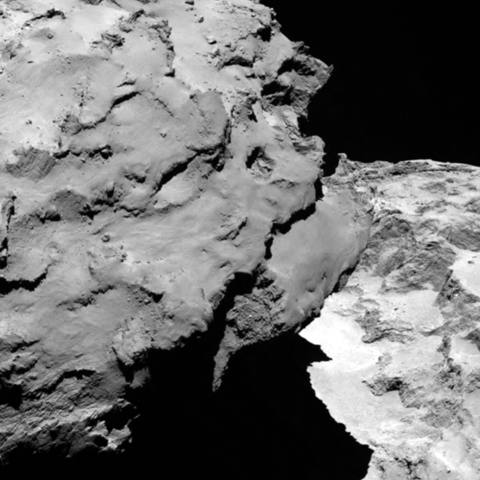
The image was taken from a distance of 120 km and the image resolution is 2.2 metres per pixel. Credit: ESA/Rosetta/MPS for OSIRIS Team MPS/UPD/LAM/IAA/SSO/INTA/UPM/DASP/IDA
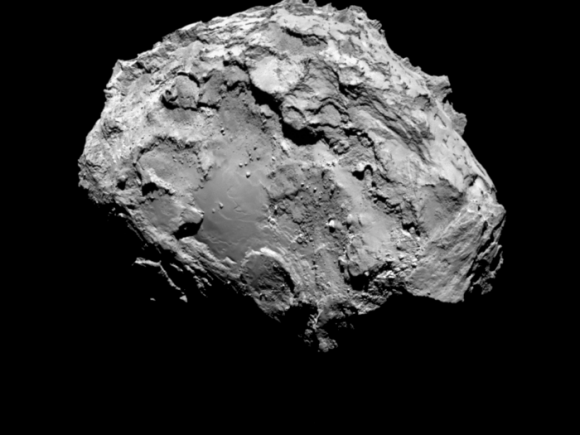
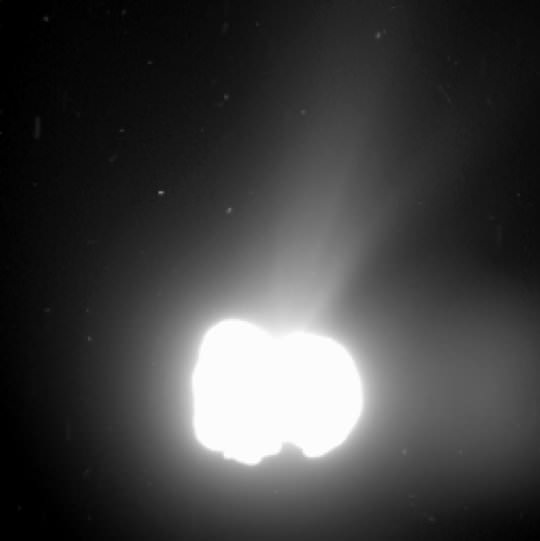
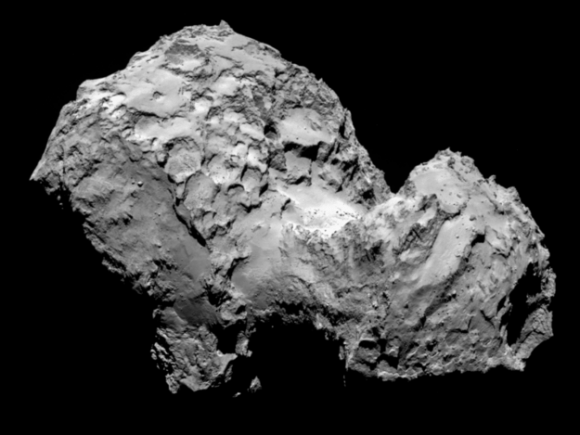
We’ll add more images as they become available, and this is just the beginning! In the next months, Rosetta will come closer than 10 kilometers to the comet’s surface, with one of the main goals to search for an appropriate landing site for the Philae lander. Philae is scheduled to touch down on the surface sometime this fall. Plus, Rosetta will stay close to the until the end of 2015. “We will have the unique opportunity to witness, how the comet’s activity forms and changes its surface”, said Sierks.
Here’s a video that shows more information of what Rosetta will be doing over the coming months:
Sources: ESA Flickr, Max Planck, ESA , ESA blog.

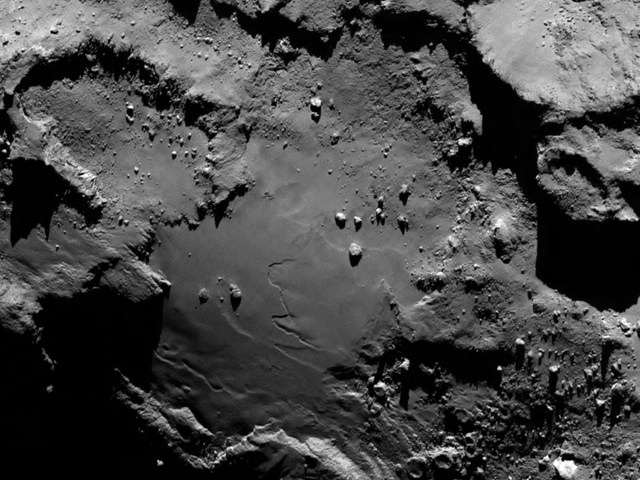
Unbelievable! Btw I wish they’d put an image scale (a 1km/mile bar) on those.
The captions say 2-5 meters per pixel
Well done ESA, stunning pictures, waiting patiently for the results from the lander later this year.
I’m out of superlatives!
Stunning is a wild understatement
and yes a SCALE would be WONDERFUL
So, help me develop an intuition about spinning rockpiles in space…
Is it held together more by gravity or adhesion?
Isn’t centrifugal force trying to tear it apart?
How long has it been since it was hot enough to fuse the big rocks?
The smooth area looks like silt, with an ‘earthquake’ fracture pattern that’s recent enough not to have re-smoothed itself…?
Here: http://www.wired.com/2014/08/comet-walk/
Those back-of-the-envelope calculations show orbital velocity is 0.46 m/s while rotation velocity at ‘equator’ (wherever that is) is 0.27 m/s.
Wow… very counterintuitive numbers. Doesn’t it seem like landing anywhere but the ‘poles’ will require impossibly delicate matching of rotational speed? If you crawled from the pole towards the equator, you’d feel yourself getting dragged into a faster rotation… and if you nudged a rock away from the equator toward a pole, it would have to get slowed down by friction…?????
In the closeup at the top of the story, it looks like some enterprising tagger got there first!
Oh, and @robotwisdom, it’s mostly ice, but otherwise your questions still apply. Is it fused and so on. We’ll find out.
Well, ice should melt pretty often if the orbit is eccentric enough, right? And doesn’t water/ice precipitate stuff that’s insoluble? So we should see separate areas of ice and rocks? And ice being covered with sand or silt or gravel sounds weird to me– most rocks don’t float…
Do the new pix show anything icy-looking to anybody?
The images have been processed so that their value range extends from black to white, but the actual object is ‘darker than fresh asphalt’ as someone said during the briefing. Don’t look for ice clues in the images!
Could the centrifugal force cause the rocks to ‘float’ to the surface of an icy core?
Per the ice melt given an eccentric orbit, I believe they’ve sussed that this is the 1st time this particular object has made it into the front yard, thus close to the sun? Anyone on this?
This comet isn’t on a particularly eccentric orbit. Gets as far as Jupiter and as close as between mars and earth. The orbital period is 6.5 years, so it’s been around the block many times. It’ll be very cool to see the changes as it gets closer to the sun and more active.
Wikipedia doesn’t offer any temperature guesses– what do we know so far? Just based on distance from Sun?
I think that you have to look at this like a snow pile in March. The moraine does not melt like ice, so it just sits on top like a blanket. Of course, this moraine has had billions of years to collect, so it might be a little deeper than that of the ordinary snow pile that is melting in March.
it’s beautiful… in its own way…
It is apparently outgassing, as seen in the overexposure, but we can’t see that in the close-up pictures. (Is it coming from the “neck” of the duck?)
I sort of expected this lack of a clear source of a tail. Even a large comet tail could be produced by small emissions from the main body since it is only “vapor”. But I am hoping for a picture that will clearly show the source of a plume. Will we see it?
“…I am hoping for a picture that will clearly show the source of a plume.”
Looking at the first picture in this article one can see several fissures or rilles that crisscross a very smooth looking area on the comet. This region reminds me of similar features on Io and Enceladus. Perhaps these features are vents along which plumes/jets may appear. That may help explain the smooth terrain surrounding these features. Just a hunch; we’ll have to wait and see.
Such a poignant reminder about the Universe’s endless penchant for the unexpected.
Using the Wikipedia figures for the comet’s mass and “1 litre per second” of water vapor lost, I think it could keep going at that rate for 100,000 years? (Half that maybe if it’s only half ice)
The comet size is like a small mountain about 4 by 3 km very odd shape, its mass is only 3E12 kg so I calculated the gravitational constant to about 50 micrometer per squared second. There is no way to walk around on this boulder as each step is a farewell. There will not be an atmospheric pressure of concern even i a third of its mass will turn into steam, an almost vacuum will always remain. To land the lander is a matter of drop the load and it will land with less than 0.5 m/s, not much needed to correct the landing spot and absorb the back-bounce. Its worst enemy is the jupiter as its huge G force is shifting its orbit and most likely also create som structural changes as this is not a solid hard rock material but rather a spongy snowball with a density a tenth of water. This is a quite and boring environment, thats the good news as it makes a mission success to be almost certain.
I just thought that the major concern at the landing maneuver is the inertia of the lander and the spongy low density surface, there is a major risk it will burry itself if it is not slowing down to almost zero ms/s.
I see a lot of comments about melting ice. This is a vacuum environment and per definition there will be no melting of ice, says no water, the ice if heated will evaporate into steam. The same goes for methane and CO2 if it is there. So far the surface is about -50degC and as it is porous it isolates well to the layers below.
The reverse if collecting fumes or debris containing H2O this will never form water but will sublimate into ice. If you have a vacuum pump reaching at least 1 mBar and connect a vessel containing water you can turn this water into ice as it boils and this ice is very strange looking, give it a try, i did it a lot of times. The vacuum at the comet surface is thousands of times better.
If you want to do some image manipulation to view things a bit differently… Try this:
1. Do a copy/paste with the above second image (not the video) into your image viewer (I’m using Irfan View),
2. Flip to a negative image, b/w -> w/b
3. Apply the “edge detection” (which emphasizes only contrast)
—————-
I’m seeing, what I think, are lots and lots of vent holes with circular formations around them. The vent holes are sometimes parallel, in groups, lines, and in circles. The smooth circular formations around the vent holes, me thinks, could be the ejecta, the dust brought up from deeper layers onto the surface and deposited around the vent holes. We can already see large flat areas are covered with the smooth dust, perhaps blown out more forcefully, and landing elsewhere on the comet.
—
My point is that with ONLY an 88×54 pixel rectangle, I’m seeing 80-100+ of these circular formations! I suspect this thing is gradually hollowing itself out with each orbit around the sun, which may explain the linear structures in this “cliff image”: ((http://www.slate.com/blogs/bad_astronomy/2014/08/14/close_up_of_67_p_has_rosetta_found_evidence_for_a_calving_event.html?wpisrc=newsletter_myslate ))
–
How can I post an image in the Comments, here?